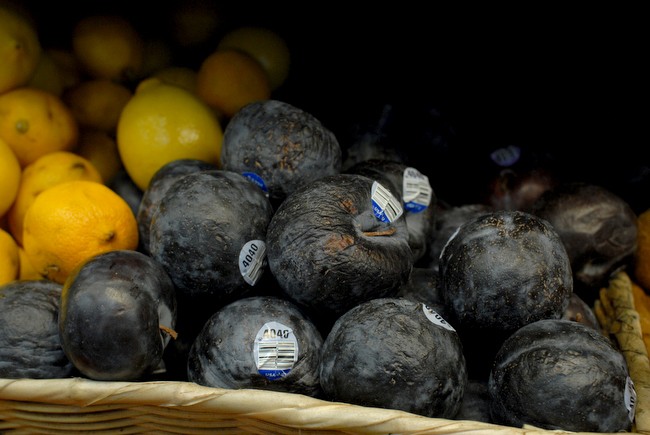
Fruit anyone? If you want to help spread healthy food and battle city hunger, read on...
Photos by Joshua Kristal
Most of us this time of year are regretting our December hedonism, staring wide-eyed at the scale after weeks of gorging on holiday meals and desserts.
Yet for thousands of kids in Brooklyn, hunger and a lack of healthy breakfasts, lunches and dinners are a daily struggle, even around holiday time.
The latest report by the N.Y.C. Coalition Against Hunger shows that one in four children in New York City are hungry, and lack adequate food at home. The numbers have increased drastically in recent years.
“Nearly half a million New York City children live in food insecure households,†meaning families do not have enough money to buy food, said Joel Berg, executive director of the hunger coalition.

Sugar is easy to find
Contrary to how we normally think of hunger—with kids starving to death, skin sunken to the ribs—hunger in the American inner-city is marked by obesity, as kids grow up on fast food that packs on the pounds while leaving the belly hungry.
And yet, last year, nearly 80 percent of the city’s soup kitchens and food pantries saw funding cuts, according to a December statement by Brooklyn City Councilman Brad Lander.
In its report this year on our city’s hunger problem, the N.Y.C. Coalition Against Hunger used computer mapping to demonstrate how low-income neighborhoods lack convenient access to supermarkets, farmers’ markets, and other sources of fresh produce and nutritious food. At the same time, these areas are scattered with fast food joints and bodegas serving unhealthy food. Fruits and veggies are often overpriced and not fresh, wilted, or even rotten.
“Food deserts,†as food activists call these areas, are scattered about Brooklyn.
Sadly, Brooklyn ranks nationally when it comes to hunger, with one of the highest increases in people who qualify as “hungry†in recent years. That news made big headlines in 2009 and 2010. The situation got worse in 2011.
Brooklyn food pantries have seen an increase in the demand for food, while shelves sometimes go bare, said Alison Cohen, a local resident and program director at WhyHunger, an organization that works nationally to foster a grass-roots end to hunger.
The hunger issue in Brooklyn is disheartening, especially as we in the Carroll Gardens/South Brooklyn area are surrounded by healthy and fine foods at our easy access.
But don’t despair. Several Brooklyn community groups and food activists are working actively to bring fresh produce to low-income areas.
**
If you’ve got a mind to help our neighbors, South Brooklyn Post is highlighting a few urban agriculture projects you can donate to, directly, through an innovative group called IOBY.
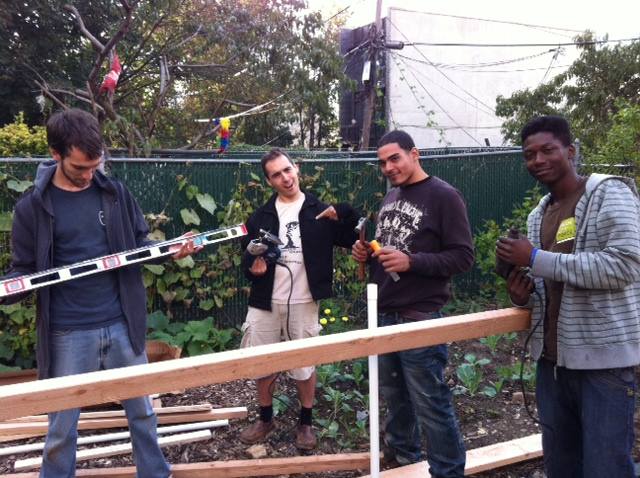
Bedford-Stuyvessant Greenhouse funded through IOBY
IOBY, which stands for “In Our Back Yards,†is a non-profit NYC fundraising site that publicizes community green and environmental projects, and helps them to raise money (see our story on them).
Last year, IOBY helped publicize the fact that the city’s Housing and Preservation Department owns 596 acres of vacant lots, lots that could be used for urban agriculture or other community projects.
After the publicity, which included a piece in the magazine Fast Company, the city began to release the lots to community groups. Many of the lots are now getting transformed into urban gardens.
“There is a movement happening, now that Housing Preservation and Development has been exposed as the owner of a lot of these vacant spaces,” says Erin Barnes, co-director of IOBY. “People are now able to turn these longtime community eyesores into something else.
“The ripple effect has been huge.â€
But not everyone is enthusiastic right now about urban gardening. While community-supported agriculture is “all the rage,†those efforts are only a “drop in the bucket†when it comes to the growing problem of American hunger, said Berg, of the NYC Hunger Coalition.
“We support community-supported agriculture and community gardens, but it’s very critical not to give the impression that these are a significant part of the solution†Berg says. “Elites feel like, if we could all grow our own food, we wouldn’t have to worry about this. But poor people don’t have the time to do this in many cases. Unless we increase wages, reduce poverty and bolster the federal nutrition safety net [aka food stamps], people just are not going to be able to afford healthy food.â€
Gardening and agriculture is seasonal, another issue. “This isn’t Southern California,†Berg says. “I like eating, and most people like eating, all 52 weeks of the year.â€
Berg has more ideas for how you can get involved. To read his point of view, check out our companion piece, Politics of Hunger, and read about the battle over Mayor Bloomberg’s policy of fingerprinting food stamp applicants.
**
In Our Back Yard
Cypress Hills, Brooklyn, is probably not a neighborhood many South Brooklynites would venture for a stroll. On the northeastern border of the borough, it is one of the lowest-income areas in the city, lying adjacent to East New York, a large area of Brooklyn thick with project housing.
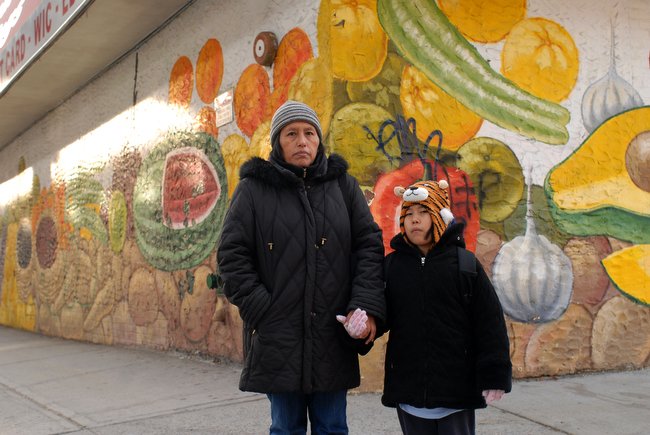
This mom is part of the People's Food Party to bring healthy food to Cypress Hills.
Cypress Hills is a “severe food desert,†says Barnes and other food activists. Families living there don’t have easy access to healthy foods or food markets. The obesity rate is 30 percent, diabetes hovers at 16 percent. Unemployment is 19 percent and 80 percent of kids quality for free lunch, with 50 percent of residents living below the poverty rate, according to the Cypress Hills Local Development Corporation.
While crime is prevalent, the primary cause of death in Cypress Hills is heart disease, according to the LDC.
The Cypress Hills LDC has worked for 25 years in the community to improve conditions—obtaining grants for low-income housing, setting up after-school programs, connecting folks with social services and the like. They funded and created a healthy-food program and hydroponic garden in the elementary school.
Recently, the development corp. held a survey in which respondents said that fast food was their only choice for dinner, and that they were ready to try farming.
So the LDC helped organize a community People’s Food Project.
The People’s Food Project launched an effort to take a vacant, overgrown, city-owned vacant lot and build a chicken run and coop on it, with 24 chickens.

Out-dated SPAM in Cypress Hills grocery. Looks delicious.
IOBY is publicizing the campaign — Pollos del Pueblo/The People’s Chickens – and Deutsche Bank Americas Fund is matching every dollar pledged.
According to the website, the project will transform the vacant lot into a hub of urban agriculture, replete with a storage shed and community compost station.
The project needs $4,600 to launch, and has raised $1,902 so far. You can donate as little or as much as you’d like. The fund, if successful, will cover costs for the chicken run and coop.
**
I talked at length with Alison Cohen, a fellow PS 29 mom, about this whole food desert issue. Cohen travels the nation to gather information on local, grassroots community farming projects, and to help disparate groups coordinate, obtain resources and learn best practices for how to get things done, with her work as program director for WhyHunger. WhyHunger works with small-scale farmers, gardeners and sustainable food projects across the nation, in cities and in the countryside.
The group’s goal is to end hunger by “connecting people to nutritious, affordable food and by supporting grassroots solutions,†according to the group’s website: whyhunger.org.
Cohen said that sometimes designating a “food desert†per se is complicated in a place like New York City. For instance, I asked her, is Red Hook a food desert?
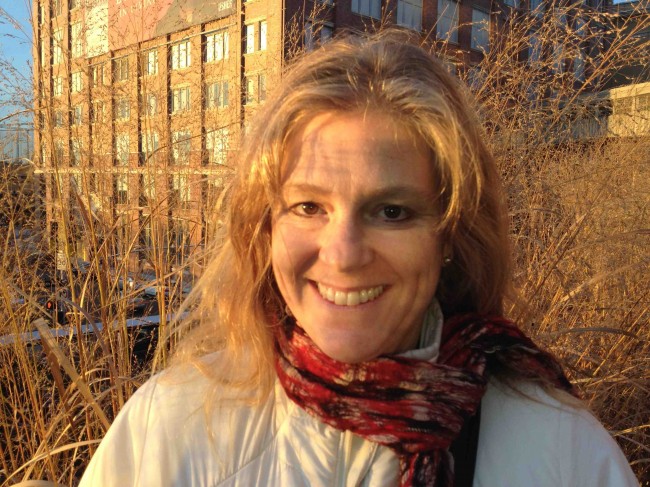
Alison Cohen, project manager for WhyHunger, and a Carroll Gardens mom
“It’s hard to imagine in a place like New York that you can’t get somewhere,†to find good food, Cohen said. “There’s Fairway in Red Hook, but it’s expensive. To shop at Fairway with food stamps, your options are limited.â€
Food insecurity is linked to poverty, housing and unemployment. Recent years have seen the largest surge in “food insecurity†since it was measured in 1995, Cohen says.
Really, food insecurity is the U.S. Department of Agriculture’s new euphemism for hunger, she says.
“It means families run out of money to buy food,†Cohen says.
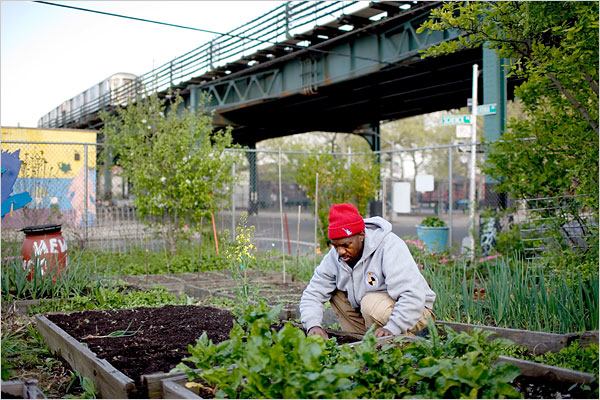
Added Value Farm in Red Hook
The Added Value Farm in Red Hook (which sits in front of Ikea) is our best local resource for urban agriculture. The farm has been running for 12 years. Its first funding source was Heifer International, for which Cohen used to work and for whom she established an urban agriculture program in Chicago, before bringing that program to New York.
“Added Value grew from guerilla gardening on an abandoned lot to acquiring several acres of parkland, and establishing a tremendous diversity of crops,†Cohen says.
Women with WIC can use their coupons at the farmer’s market, there’s a seniors program and food stamps are accepted. There’s lots of work to do so if you’re looking to volunteer, give them a buzz.
Though urban gardening and agriculture has been a booming national trend, the concept is still new to some, Cohen says.
“I grew up in the rural South, in farm country, and the idea that people would grow food in the city was really oxymoronic,†Cohen said.
Now, however, urban gardening is not only a hobby, but also a real source of food among local communities, and a method for community building, Cohen said.
“Grass roots connections help build community power. That’s the work that Why Hunger does. We do it in a variety of ways, helping to build capacity around the country. We hope to contribute to a national movement that really appreciates and underscores the right to food, so that people understand food as a basic human right.â€
She points out that now, more than ever, it’s important to donate cash to food pantries.
“There’s a tremendous amount of pantries with bare shelves and increased demand,†Cohen said.
If you are donating food, make sure it’s healthy food, she says.
For folks really wanting to volunteer time, Cohen also suggests St. John’s Bread and Life, in Bed-Stuy, “an amazing emergency food†service, she says, that “brings dignity to the process.â€
Why Hunger’s website also has a plethora of resources on how to get involved. Check it out.
**
A little closer to home, IOBY raised $1,417 for a community garden at 462 Halsey Street in Bedford-Stuyvesant, and is now helping the community group find volunteers. Want to get your hands dirty? Here’s your chance!
The lot has been vacant for 20 years. It’s now co-managed by the city’s Department of Housing, Preservation and Development and Green Thumb. Residents are starting a garden with 10 beds. The fundraiser paid for lumber, soil, seed, bulbs, rakes, pruners, hay, straw bails and gardening supplies.
To find out about volunteering, visit: https://ioby.org/project/462-halsey-street-community-garden
**
Gowanus Directional Project
Another project IOBY is publicizing is taking place right in our backyard — literally. Living City Block, a website that provides resources for residents who want to “green†their neighborhood, has partnered with the Gowanus Community Development Corporation to launch a signage project that would make getting around the Gowanus easier for pedestrians and bikers, and direct folks to creative and “green†locations, such as bike racks, solar panels, community gardens, etc.
The project needs $4,115 and has raised $45 so far :Â https://ioby.org/project/living-city-brooklyn-gowanus
___
Resources:
Cohen recommends checking out The Greenpoint Reform Church’s Hunger Program. The church participates in anti-hunger advocacy and they encourage volunteers. A graph on the website shows the increased need of food providers in light of federal cuts.
http://greenpointchurch.org/
She also recommends, as a “favorite food pantry” (how awesome is it to have a `favorite’ food pantry?), Neighbors Together in Bed-Stuy. The site has statistics showing hunger in our neighboring community compared to the national average. They also work with people to try to figure out why they are food insecure, and what they can do about it.
http://neighborstogether.org/stats.html
N.Y.C. Coalition Against Hunger:Â http://www.nyccah.org/learn-about-hunger/hunger-in-nyc
WhyHunger’s national hotline for people who need emergency, healthy food:Â http://blog.whyhunger.org/2011/11/stories-from-the-national-hunger-hotline-a-neighbors-advocacy/
And the National Hunger Clearinghouse: Â http://www.whyhunger.org/findfood
